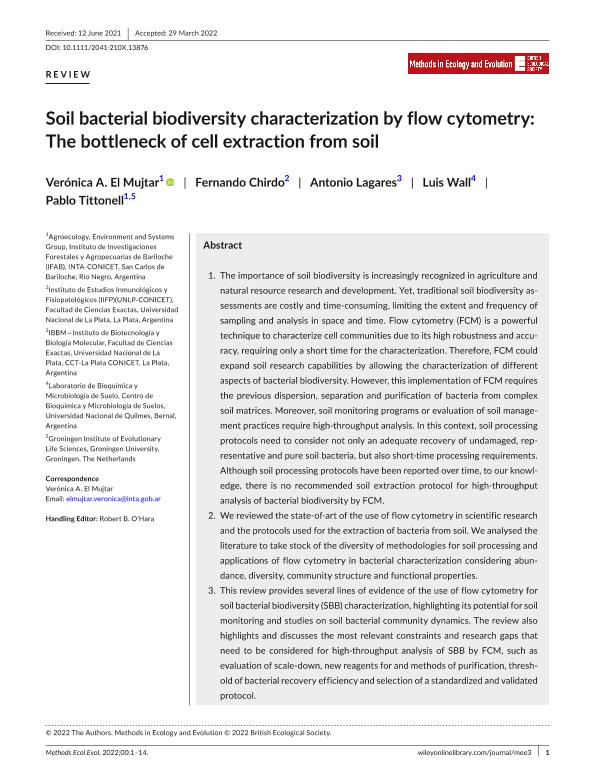Mostrar el registro sencillo del ítem
dc.contributor.author
El Mujtar, Verónica Andrea

dc.contributor.author
Chirdo, Fernando Gabriel

dc.contributor.author
Lagares, Antonio

dc.contributor.author
Wall, Luis Gabriel

dc.contributor.author
Tittonell, Pablo

dc.date.available
2023-02-09T16:38:09Z
dc.date.issued
2022-07
dc.identifier.citation
El Mujtar, Verónica Andrea; Chirdo, Fernando Gabriel; Lagares, Antonio; Wall, Luis Gabriel; Tittonell, Pablo; Soil bacterial biodiversity characterization by flow cytometry: The bottleneck of cell extraction from soil; Wiley; Methods in Ecology and Evolution; 13; 7; 7-2022; 1388-1401
dc.identifier.issn
2041-210X
dc.identifier.uri
http://hdl.handle.net/11336/187517
dc.description.abstract
The importance of soil biodiversity is increasingly recognized in agriculture and natural resource research and development. Yet, traditional soil biodiversity assessments are costly and time-consuming, limiting the extent and frequency of sampling and analysis in space and time. Flow cytometry (FCM) is a powerful technique to characterize cell communities due to its high robustness and accuracy, requiring only a short time for the characterization. Therefore, FCM could expand soil research capabilities by allowing the characterization of different aspects of bacterial biodiversity. However, this implementation of FCM requires the previous dispersion, separation and purification of bacteria from complex soil matrices. Moreover, soil monitoring programs or evaluation of soil management practices require high-throughput analysis. In this context, soil processing protocols need to consider not only an adequate recovery of undamaged, representative and pure soil bacteria, but also short-time processing requirements. Although soil processing protocols have been reported over time, to our knowledge, there is no recommended soil extraction protocol for high-throughput analysis of bacterial biodiversity by FCM. We reviewed the state-of-art of the use of flow cytometry in scientific research and the protocols used for the extraction of bacteria from soil. We analysed the literature to take stock of the diversity of methodologies for soil processing and applications of flow cytometry in bacterial characterization considering abundance, diversity, community structure and functional properties. This review provides several lines of evidence of the use of flow cytometry for soil bacterial biodiversity (SBB) characterization, highlighting its potential for soil monitoring and studies on soil bacterial community dynamics. The review also highlights and discusses the most relevant constraints and research gaps that need to be considered for high-throughput analysis of SBB by FCM, such as evaluation of scale-down, new reagents for and methods of purification, threshold of bacterial recovery efficiency and selection of a standardized and validated protocol. We proposed a protocol for soil bacterial extraction for high-throughput analysis of SBB by FCM and we provided detailed databases of systematized information that would be useful to the scientific community.
dc.format
application/pdf
dc.language.iso
eng
dc.publisher
Wiley

dc.rights
info:eu-repo/semantics/openAccess
dc.rights.uri
https://creativecommons.org/licenses/by-nc-sa/2.5/ar/
dc.subject
FLOW CYTOMETRY
dc.subject
HIGH-THROUGHPUT ANALYSIS
dc.subject
SOIL BACTERIAL BIODIVERSITY
dc.subject
SOIL BACTERIAL EXTRACTION
dc.subject
SOIL BACTERIAL RECOVERY EFFICIENCY
dc.subject.classification
Ecología

dc.subject.classification
Ciencias Biológicas

dc.subject.classification
CIENCIAS NATURALES Y EXACTAS

dc.title
Soil bacterial biodiversity characterization by flow cytometry: The bottleneck of cell extraction from soil
dc.type
info:eu-repo/semantics/article
dc.type
info:ar-repo/semantics/artículo
dc.type
info:eu-repo/semantics/publishedVersion
dc.date.updated
2023-02-08T15:37:43Z
dc.journal.volume
13
dc.journal.number
7
dc.journal.pagination
1388-1401
dc.journal.pais
Reino Unido

dc.journal.ciudad
Londres
dc.description.fil
Fil: El Mujtar, Verónica Andrea. Instituto Nacional de Tecnología Agropecuaria. Centro Regional Patagonia Norte. Estación Experimental Agropecuaria San Carlos de Bariloche. Instituto de Investigaciones Forestales y Agropecuarias Bariloche. - Consejo Nacional de Investigaciones Científicas y Técnicas. Centro Científico Tecnológico Conicet - Patagonia Norte. Instituto de Investigaciones Forestales y Agropecuarias Bariloche; Argentina
dc.description.fil
Fil: Chirdo, Fernando Gabriel. Consejo Nacional de Investigaciones Científicas y Técnicas. Centro Científico Tecnológico Conicet - La Plata. Instituto de Estudios Inmunológicos y Fisiopatológicos. Universidad Nacional de La Plata. Facultad de Ciencias Exactas. Instituto de Estudios Inmunológicos y Fisiopatológicos; Argentina
dc.description.fil
Fil: Lagares, Antonio. Consejo Nacional de Investigaciones Científicas y Técnicas. Centro Científico Tecnológico Conicet - La Plata. Instituto de Biotecnología y Biología Molecular. Universidad Nacional de La Plata. Facultad de Ciencias Exactas. Instituto de Biotecnología y Biología Molecular; Argentina
dc.description.fil
Fil: Wall, Luis Gabriel. Universidad Nacional de Quilmes. Departamento de Ciencia y Tecnología; Argentina. Consejo Nacional de Investigaciones Científicas y Técnicas; Argentina
dc.description.fil
Fil: Tittonell, Pablo. Groningen Institute Of Evolutionary Life Sciences; Países Bajos. Instituto Nacional de Tecnología Agropecuaria. Centro Regional Patagonia Norte. Estación Experimental Agropecuaria San Carlos de Bariloche. Instituto de Investigaciones Forestales y Agropecuarias Bariloche. - Consejo Nacional de Investigaciones Científicas y Técnicas. Centro Científico Tecnológico Conicet - Patagonia Norte. Instituto de Investigaciones Forestales y Agropecuarias Bariloche; Argentina
dc.journal.title
Methods in Ecology and Evolution
dc.relation.alternativeid
info:eu-repo/semantics/altIdentifier/doi/http://dx.doi.org/10.1111/2041-210X.13876
Archivos asociados
